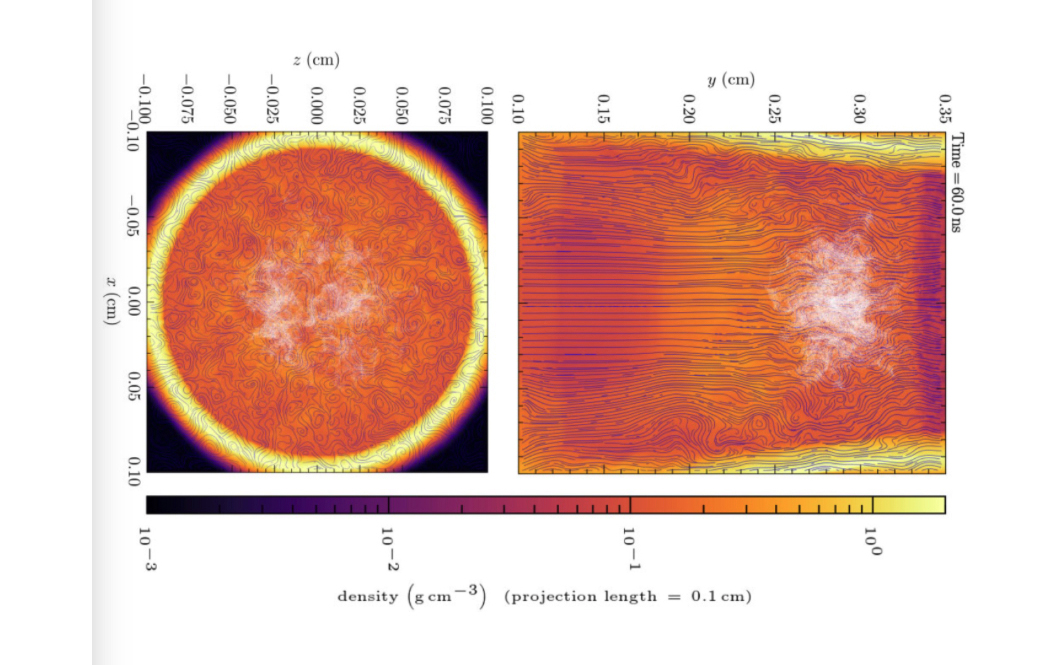Research Byte - Astrophysical flows

Astrophysical flows, which encompasses a wide range of dynamic phenomena like supernovae, accretion discs, and galactic outflows, are driven by complex interactions of various physical processes. Among these interactions, the interplay between shock waves and magnetised turbulence holds a crucial role. Shocks, characterised by rapid variations inpressure and density; Turbulence, characterised by chaotic and irregular fluid motion, often coexist in these environments, giving rise to fascinating and intricate phenomena that shape the behaviour and evolution of astrophysical systems in the interstellar medium (ISM), which are typically weakly magnetised with fields of order nano to micro-Gauss.
The study of shock-turbulence interactions occurring within both hydrodynamics and magnetohydrodynamics (MHD) thus plays an integral role in the understanding of astrophysical flows. This is precisely what we set out to study in a series of papers on shockreflection phenomena and shock tube numerical experiments including “Analytical and Numerical Studies of a Type-II Asymmetric Cap Shock Mach Reflec&on in Over-expanded Supersonic Jets” and “Lagrangian statistics of a shock-driven turbulent dynamo in decaying turbulence”. Particularly, we were interested in quantifying the enhancement of vorticity and turbulence as a result of shock curvatures and density inhomogeneities, which is directly pertinent to the amplification of turbulent magnetic fields injected within the medium.
The results we obtained from numerical simulations, along with several concomitant experiments being conducted at the National Ignition Facility of the Lawrence Livermore National Laboratory (LLNL) proved to have valuable implications to further understanding these phenomena, especially including the magnetisation of turbulent astrophysical flows. We found that single strong shocks appear to create sufficiently controlled, localised regions of turbulence, which then spontaneously amplify magnetic fields at an exponential rate. The growth of these fields is however, hindered by the subsequent decay of turbulence following the passage of the shock. These results therefore present important insights into the nature of shock-turbulence interactions in various applications, where turbulence can only be generated intermittently, before dissipating away through an epoch of rapid decay (e.g. the compression-depression of galaxy clusters).
The implications of these findings extend to broader astrophysical contexts. For instance, they shed further light on the development of turbulent magnetic fields in the modern Universe, impacting our understanding of phenomena like the formation of cosmic structures, the generation of magnetic fields within galaxies, and the behaviour of fluids in highly supersonic conditions around compact objects like black holes and neutron stars. Therefore, we hope that our current studies inspire further such works, and provides novel insights into the field.
Justin Kin Jun Hew (ORCID: https://orcid.org/0000-0002-5238-6115)
Hew, J. K. J., Boswell, R. W., Federrath, C., Gopalapillai, R., & Paramanantham, V. (2022). Analytical and Numerical Study of the Non-uniformity induced Type II Asymmetric Cap Shock Mach Reflection in Over-expanded Supersonic Jets. arXiv preprint arXiv:2210.04713.
Hew, J. K. J., & Federrath, C. (2023). Lagrangian sta6s6cs of a shock-driven turbulent dynamo in decaying turbulence. Monthly Notices of the Royal Astronomical Society, 520(4), 6268-6282.
Fig. 1 Density distribution in the shock tube showing the Lagrangian volume in the post-shock medium at ? = 60ns, where the shock has propagated to the outer extent of the medium. The Lagrangian volume consists of about 2 million tracers. The volume chosen is a cylinder with radius 0.03 cm, in accordance with the flow configuration itself. (a) ?- projected density distribution, (b) ?-projected density distribution, centred on the respective mid-plane of the shock tube. Tracer particles are shown as white points, and the blue lines are magnetic streamlines, which indicate the filamentary and turbulent nature of the post-shock medium as a result of shock-turbulence interactions.
